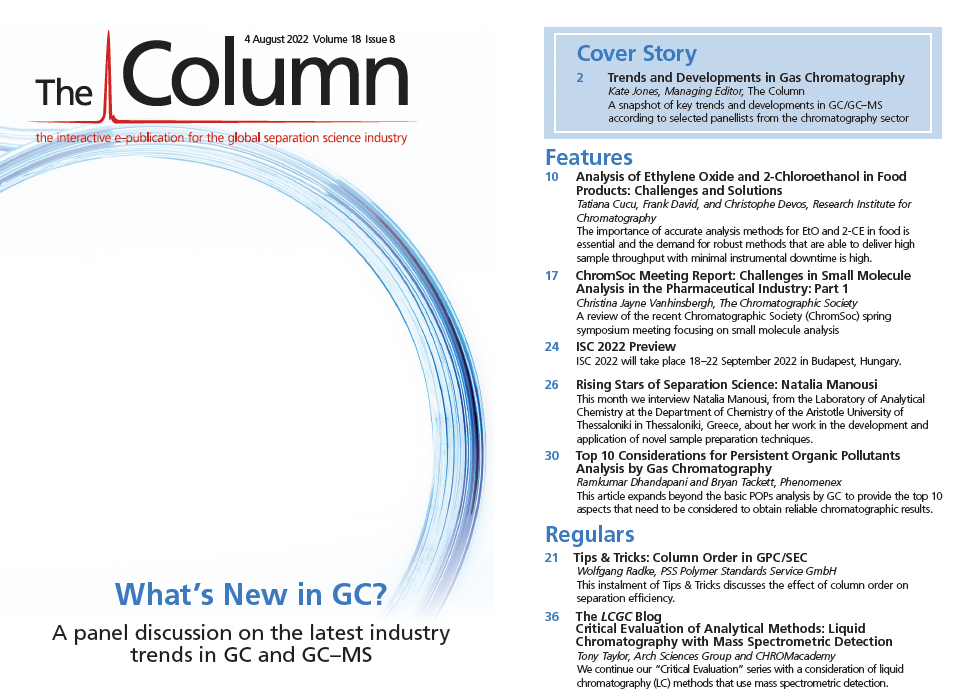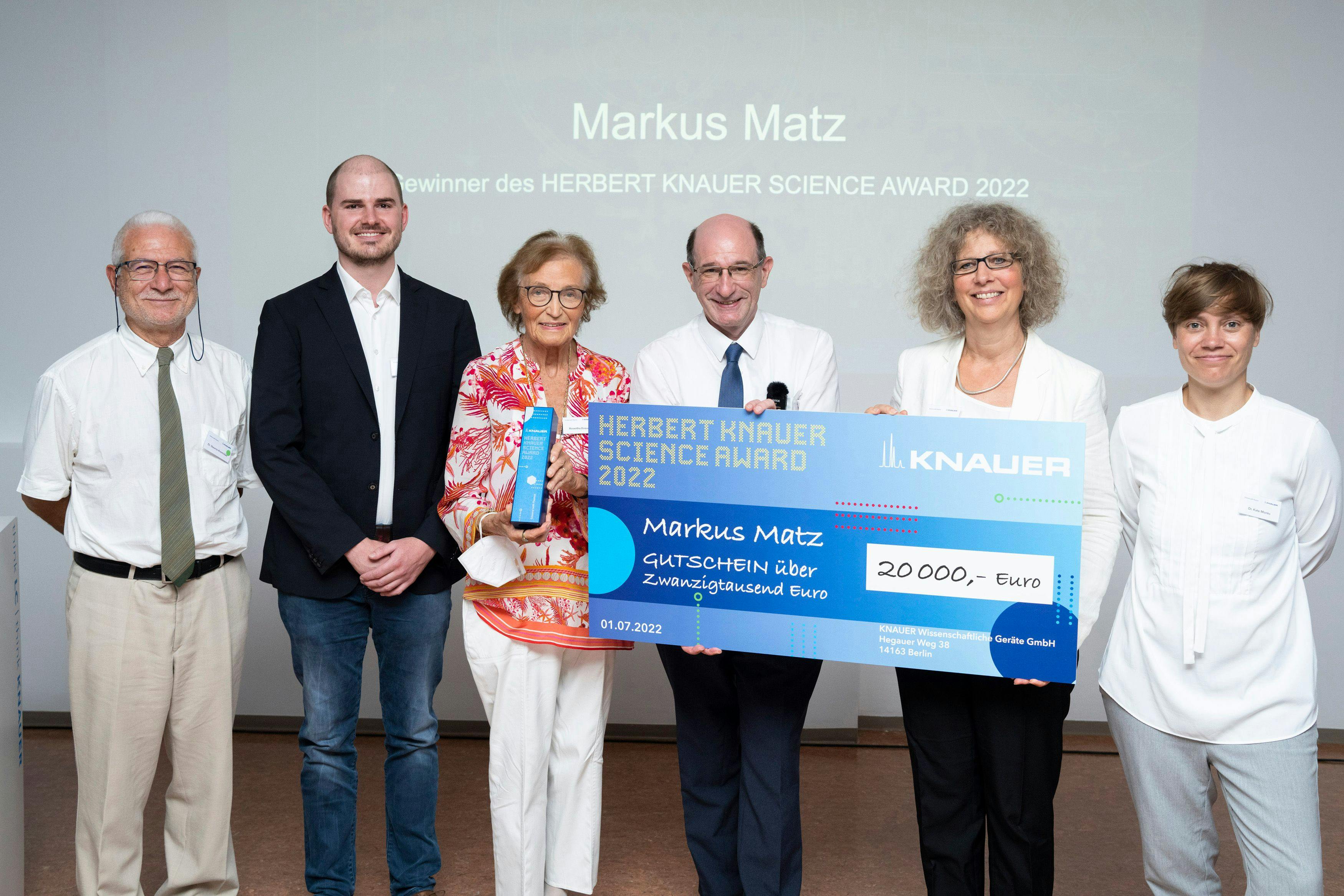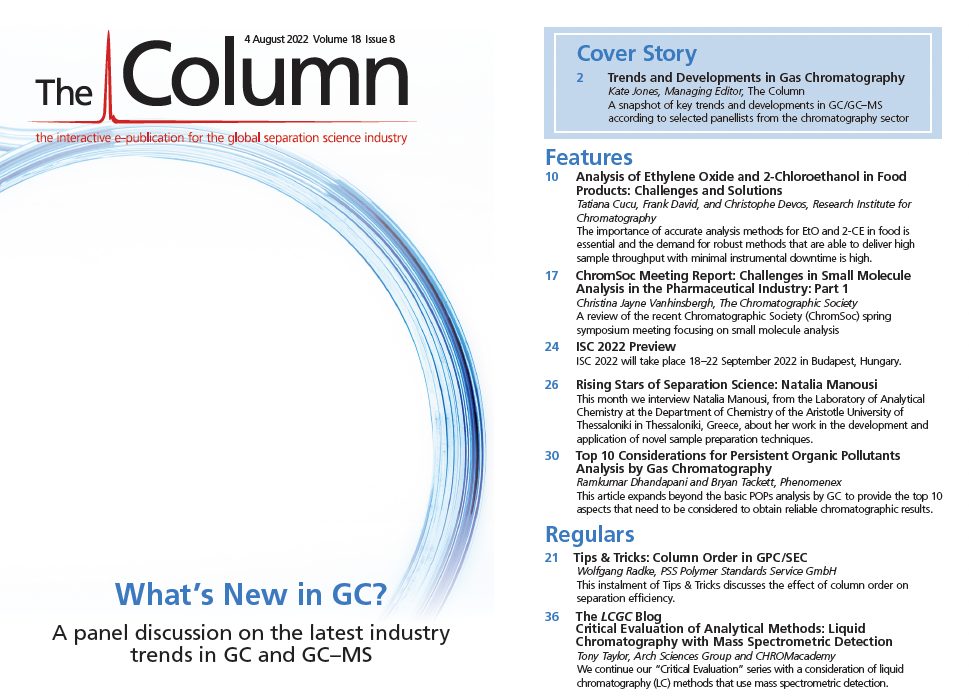ChromSoc Meeting Report: Challenges in Small Molecule Analysis in the Pharmaceutical Industry: Part 1
The first part of a review of the recent Chromatographic Society (ChromSoc) spring symposium meeting focusing on small molecule analysis.
Day One (19 May 2022)
Session 1: Small Molecule Analysis—Pharmaceuticals: The Application of HTS to Finding New Drugs: The Chromatographic Society (ChromSoc) Spring symposium began with a welcome address from Tony Edge (current president), who introduced our partners LCGC Europe, who were filming the event and interviewing attendees/speakers. After a short welcome, Tony introduced keynote presenter Tim Underwood from GlaxoSmithKline (GSK). Tim’s presentation “Challenging Existing Screening Strategies” highlighted the importance of continuous optimization of small molecule screening approaches. As speed of synthesis is a high priority driver in the pharmaceutical industry, analysts are continually shouldering the demands of small molecule purification. Tim discussed that chromatographic screening approaches help to reduce process turnaround times and enable efficient scale-up to purification. In respect to chiral separations, Tim highlighted that 5–6 years ago, 32 chiral separations could be performed in a 72-h period using a combination of normal-phase and polar organic screens. As demand has increased, GSK has updated their instruments and columns to achieve faster separation times and increase the amount of chiral separations performed. With these updates and the exploitation of further selectivity by including a supercritical fluid chromatography (SFC) system within their instrumentation, 93 separations could be performed in a 2-h window. Implementation of secondary screening (for example, using aqueous reversed-phase conditions) increased this number to 422 in 50 h, which is a 1200% improvement in chiral recognition systems. Tim also discussed achiral screening approaches and how GSK have optimized achiral screening using the same approach as chiral. His take home message was that SFC and high performance liquid chromatography (HPLC) enable an orthogonal screening approach and the most comprehensive strategy for small molecules.
Lewis Couchman from Analytical Services International (ASI) was next to present. His talk “Turning your LC–MS ‘Up to Eleven’: Progress in Ultra-Rapid Bioanalysis by LC–MS” began with re-emphasizing Tim Underwood’s point on continuous optimization for faster results. ASI must get results back to clinicians quickly to facilitate rapid clinical treatment decisions. Lewis has effectively ditched the chromatographic column to perform flow injection mass spectrometry (MS) in under 60 s. The issues Lewis experiences when analyzing biological samples are matrix effects, which can become rate limiting. To overcome this, Lewis and his colleagues re-introduced a 5 mm column and high flow rate to perform high resolution LC–MS within 21 s. The result of this approach is decreased matrix effects and minimal delay volume by attaching the LC column straight onto the MS source. Lewis also presented an interesting case study of rapid dissolution profile testing on 25 years’ worth of ecstasy tablets to profile historical dose changes. Rapid LC–MS analysis enabled 1200 samples to be analyzed per night. His take-home message was that high-resolution instrumentation coupled with pushing the separation speed to as fast as you can (turning it up to 11) assists in rapid analytical turnarounds.
The next presentation was “Automating Analytical Data Batch-Processing in Drug Discovery with MGears” by Sylvain Demanze from AstraZeneca. Sylvain highlighted the fact that laboratories are fast acquiring a range of robotics to perform high-throughput experiments. The high-throughput instruments generate a large volume of data and the associated software may not process that data according to the needs of a screen. A level of “in-house” manual processing may be required, which is challenging if you have many data sets to process. MGears is a plugin of Mnova software that allows the user to set up automated analytical workflows. Sylvain has been using the software to perform proactive system suitability testing of instruments, reaction screening experiments, and large-scale solvent screening for solubilization of product impurities.
To conclude the morning’s sessions, Richard Blankley from Agilent presented “High‑Throughput Mass Spectrometry Analysis of Synthetic Oligonucleotides—A Comparison of Data from Fast LC and RapidFire Methods”. Richard presented Agilent’s RapidFire 400 high throughput system for microfluidic solid-phase extraction coupled with MS screening. The instrument can hold 140,000 samples and analytical run times are between 3–15 s. Richard showed that the data are comparable with fast LC–MS, reproducible, and quantitative and this was demonstrated by case reports on pharmaceutical metabolomic studies and nitrosamine analysis.
After this, the vendors exhibited over lunch. Representatives from VWR International, Buchi UK, Crawford Scientific, Fortis Technologies, Avantor, Agilent, Elga Veolia, ATG, and LCGC Europe were networking with delegates and presenting the latest products and technologies available for small molecule analysis or purification.

Session 2: Small Molecule Analysis—Pharmaceuticals: The Analysis of Impurities: Lewis Jones from Sensient Flavors kicked off session 2 with his presentation “Eating Ice Cream and Chemical Analysis—The Joy of Working With Vanilla”. He highlighted that his company wants to bring joy to people through their work and brought vanilla ice cream for the delegates to eat while he presented. He introduced the physiochemical processes surrounding taste and aroma and the chemicals that are involved in our perception of aroma. Vanilla originates from South America, but is primarily grown in Madagascar. The beans are hand pollinated by the farmers, which results in the high expense of vanilla. Vanilla is extracted from these beans through solvent extraction processes (via ethanol, water, and carbon dioxide). This creates a range of different flavours for food or perfume uses at a range of concentrations. The main quality marker in the flavour is vanillin, which is analyzed using HPLC; however, his company analyze numerous flavour compounds using gas chromatography–flame ionization detection (GC–FID) and HPLC–diode array detection (DAD) for quality control (QC) of their products. Lewis demonstrated the “sensomics” approach to quality, which focuses on identifying compounds associated with aroma, followed by their quantitation. Discrimination testing is performed to validate the compounds in a product by a “napping method”, which is a descriptive approach to assess samples. This approach enables discrimination between species of vanilla beans and different extraction processes.
The next presentation was “Method Development Strategies for Nitrosamine Analysis” by Brian Montgomery from Avantor. Brian highlighted that nitrosamines are formed between amines and nitrate salts and can potentially form within many different products (food, plastics, pharmaceuticals, cosmetics, and environmental products). These small compounds are genotoxic and potentially carcinogenic, which creates a requirement to characterize their presence within different products. In 2021, the FDA released control guidelines regarding nitrosamines after trace levels of nitrosodimethylamine were found in the pharmaceutical Valsartan in 2018. LC–UV–MS is a sensitive approach for nitrosamine analysis, and Brian presented methods for Valsartan. Chemicalize.org was used to calculate physicochemical properties for a modelling approach to optimize the method. A reversed-phase LC quantitative multiple reaction monitoring (MRM) MS experiment was used with stable isotope internal standards to identify nitrosamines within samples with <3% CV. Brian stipulated that a critical element to optimizing the method is choosing the right internal standard and MRM transitions for each analyte.
The final presentation was by Andrew Feilden from Hall Analytical, who presented “Extractables and Leachables: The What, The Why, The How”. Andrew began with introducing the concept of safe pharmaceutical products that have not been altered by extractable or leachable compounds from the product container, or that contain any toxic compounds extracted or leached from the container. A range of tests are performed to analyze volatile, semivolatile, nonvolatile, and elemental compounds, including GC headspace analysis, GC–MS, LC–UV, LC–MS, LC–charged aerosol detection (CAD), and inductively coupled plasma–mass spectrometry (ICP-MS). Techniques need to be sensitive enough or coupled with concentration approaches to identify extractable or leachable compounds present at low levels. Identification of the compounds is key, so there is a high dependence on using multiple methods to characterize the cohort of extractables and leachables present within the drug formulation.
Session 3: Small Molecule Analysis—Pharmaceuticals: Quality by Design: John Dean from Northumbria University was the keynote speaker for the final session of day one, presenting “Designing an Exogeneous Volatile Organic Compound for Biomedical Analysis”. He described a project he has collaborated within for the past decade with Biomerieux—developing alternatives to bacterial culture analysis of biosamples within hospitals. One way of identifying specific bacteria is via the enzymatic generation of volatile organic compounds (VOCs) that can be identified by GC–MS analysis. John described the quality‑by-design (QbD) approach to developing a pathway to exogeneous VOC generation, identifying the considerations for endogenous enzymes present within specific bacteria, the enzyme substrate, and influences on detection and extraction of the analytes. He presented a case study where C. difficile was identified by adding 3-fluoro-4-hydroxyphenylacetic acid substrate to the culture sample to enzymatically react with p-hydroxyphenylacetate decarboxylase within the bacteria and produce VOC 2-fluoro-4-methylphenol. This was sequentially analyzed using optimized GC–MS to identify the bacteria within the samples. John highlighted that some bacteria, such as salmonella, will naturally emit hydrogen sulfide that can be analyzed using static headspace multi-capillary column GC-ion mobility spectrometry.
The final presentation of the day was “Development of Oligonucleotide Impurity Methods within an AQbD Framework” by Chris Gripton from GlaxoSmithKline. Chris described an analytical target profile approach to optimizing ion-pair reversed-phase chromatography assays for oligonucleotide therapeutics. These molecules are highly chemically modified and this leads to a large range of oligonucleotide impurities from synthesis or degradation pathways. The current assay methods employ LC–UV–MS analysis and Chris described how GSK are developing simpler methods for oligonucleotides. He highlighted that along with the analytical target profile, in silico LC method development tools are used for method optimization. The amine and counterion choice (or combinations thereof) is critical for chromatographic and mass spectrometry performance and to avoid on-column degradation of the oligonucleotide therapeutic. A design of experiments (DoE) approach was applied to method parameters such as source settings, temperature, and flow rate to optimize accuracy, selectivity, and sensitivity. Chris demonstrated that optimization of methods for oligonucleotides creates simpler, complementary approaches to assay impurities or active pharmaceutical ingredients (APIs) by LC–UV or LC–MS, and an analytical quality-by-design (AQbD) framework is a key tool in focusing on development strategy.
The evening was concluded with a barbeque within the racecourse and evening networking among the vendors, delegates, and speakers.
Part 2 of this ChromSoc meeting report will be published in a future issue of The Column.
Christina Jayne Vanhinsbergh is with The Chromatographic Society.
E-mail: enquiries@chromsoc.com
Website: www.chromsoc.com

Separating Impurities from Oligonucleotides Using Supercritical Fluid Chromatography
February 21st 2025Supercritical fluid chromatography (SFC) has been optimized for the analysis of 5-, 10-, 15-, and 18-mer oligonucleotides (ONs) and evaluated for its effectiveness in separating impurities from ONs.















